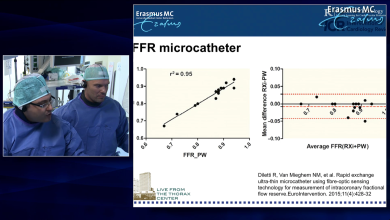Search results
Author(s):
Goran Stankovic
,
Zlatko Mehmedbegovic
,
Milorad Zivkovic
Added:
3 years ago
Approximately 15–20% of percutaneous coronary interventions (PCIs) are performed to treat coronary bifurcations. These procedures are renowned for being technically challenging and historically have been associated with lower procedural success rates and worse clinical outcomes compared with non-bifurcation lesions.1,2
A bifurcation lesion is a lesion occurring at, or adjacent to, a significant…
View more
Author(s):
Shao-Liang Chen
,
Imad Sheiban
Added:
3 years ago
Bifurcation lesions account for approximately 20–30% of all percutaneous coronary interventions (PCIs). Coronary bifurcation sites are prone to developing obstructive atherosclerotic disease due to turbulent blood flow and change of shear stress. With the complexity of bifurcation lesions, several classification systems have been advocated in order to extablish percutaneous strategies.1–3 In fact…
View more
Dedicated Bifurcation Drug-eluting Stent BiOSS® – A Novel Device for Coronary Bifurcation Treatment
Author(s):
Robert Gil
,
Dobrin Vassilev
,
Jacek Bil
Added:
3 years ago
Article
Left Main Bifurcation Live Case Series
Added:
3 years ago
Video Series
Author(s):
Yves Louvard
,
Marie-Claude Morice
,
Thomas Hovasse
,
et al
Added:
3 years ago
Due to anatomical reasons and the distributive function of the coronary tree, bifurcation sites are prone to the development of atherosclerotic lesions as a result of flow turbulence generating pro-atherogenous low wall shear stress (WSS). Over the past few years, coronary bifurcation lesions have been the subject of intense therapeutic discussions fuelled by new definitions, classifications …
View more
Author(s):
Nicolas M Van Mieghem
Start date:
Dec 08, 2015
During coronary revascularisation involving a main vessel and a side branch, it is unclear whether ballooning of the side branch is a prerequisite for long term clinical success. Coronary physiology techniques such as Fractional Flow Reserve (FFR) provide a unique way to scientifically quantify whether a side-branch may need revascularisation following treatment of the main vessel.
Frequently it…
View more
Author(s):
Luca Longobardo
,
Alessio Mattesini
,
Serafina Valente
,
et al
Added:
3 years ago
Coronary artery bifurcation lesions are treated in 15–20% of percutaneous coronary intervention (PCI) procedures and are still plagued by worse outcomes.1 This is in spite of recent significant advancements in stent technology in general and in bifurcation stenting techniques in particular. Conventional angiography provides only limited information about bifurcation anatomy, plaque distribution…
View more
Start date:
May 13, 2021
End date:
May 13, 2021
Live Case #4:Lesion preparation
13 May 2021
16:00 GMT / 17:00 CET
View more
Author(s):
Roberto Diletti
Added:
8 years ago
During coronary revascularisation involving a main vessel and a side branch, it is unclear whether ballooning of the side branch is a prerequisite for long term clinical success. Coronary physiology techniques such as Fractional Flow Reserve (FFR) provide a unique way to scientifically quantify whether a side-branch may need revascularisation following treatment of the main vessel.
Frequently…
View more
Start date:
Nov 11, 2021
End date:
Nov 11, 2021
Live Case #6: Culotte Technique
11 November 2021, UK
16:00 GMT / 17:00 CET
View more














